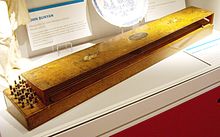
An Aeolian harp (also wind harp) is a musical instrument that is played by the wind. Named after Aeolus, the ancient Greek god of the wind, the traditional Aeolian harp is essentially a wooden box including a sounding board, with strings stretched lengthwise across two bridges. It is often placed in a slightly opened window where the wind can blow across the strings to produce sounds. The strings can be made of different materials (or thicknesses) and all be tuned to the same pitch, or identical strings can be tuned to different pitches. Besides being the only string instrument played solely by the wind, the Aeolian harp is also the only string instrument that plays solely harmonic frequencies.[1] They are recognizable by the sound which is a result of this property, which has been described as eerie[2] and ethereal.[3]
The Aeolian harp – already known in the ancient world – was first described by Athanasius Kircher (1602–1680) in his books Musurgia Universalis (1650)[4] and Phonurgia Nova (1673). It became popular as a household instrument during the Romantic era, and Aeolian harps are still hand-crafted today. Some are now made in the form of monumental metal sound sculptures located on the roofs of buildings and windy hilltops.
The quality of sound depends on many factors, including the lengths, gauges, and types of strings, the character of the wind, and the material of the resonating body. Metal-framed instruments with no sound board produce a music very different from that produced by wind harps with wooden sound boxes and sound boards. There is no percussive aspect to the sound like that produced by a wind chime; rather crescendos and decrescendos of harmonic frequencies are played in rhythm to the winds. As Aeolian harps are played without human intervention, the sounds they produce are an example of aleatoric music.
Aside from varying in material, Aeolian harps come in many different shapes. Some resemble standard harps,[3] others box zithers,[4] others lyres,[5] and, in one monument, a fiddle.[5] More modern Aeolian harps can more closely resemble lawn ornaments than any traditional string instrument. The unifying characteristic between all Aeolian harps, regardless of appearance, is their source of sound, the strings, and the fact they are played by the wind. This distinguishes Aeolian harps from other instruments played by the wind, such as wind chimes.
- ^ "Wind Harp Physics" (PDF). Shop Smith Academy. n.d. Archived (PDF) from the original on 2009-01-05. Retrieved March 11, 2021.
- ^ Heller, Eric J. (2013). Why You Hear what You Hear: An Experiential Approach to Sound, Music, and Psychoacoustics. Princeton University Press. p. 403. ISBN 978-0-691-14859-5.
- ^ a b "Tempest Song, Our Second Windharp". Nfo.edu. Retrieved 2021-03-11.
- ^ a b "Aeolian harp | musical instrument". Encyclopedia Britannica. Retrieved 2021-03-11.
- ^ a b White, Chris (2014-08-22). "Eerie Instruments Played by the Wind". Atlas Obscura. Retrieved 2021-03-11.